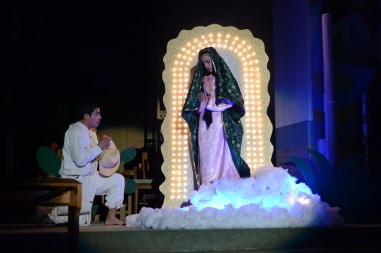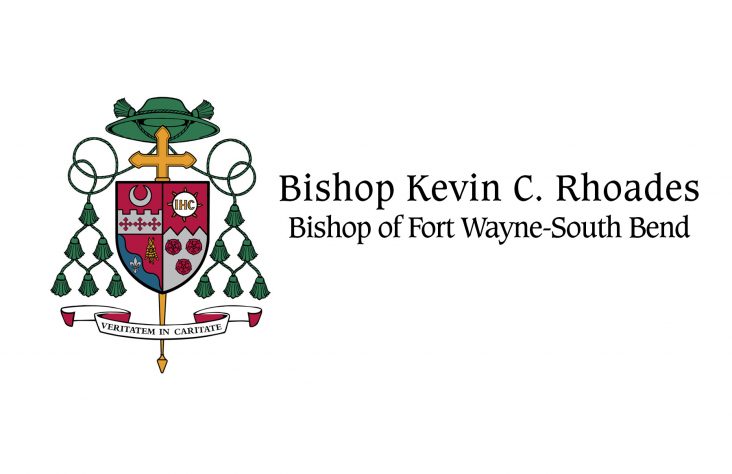December 17, 2013 // Uncategorized
Our Lady of Hungary Parish celebrates feast of Our Lady of Guadalupe

Actors from Our Lady of Hungary Parish present the story of Juan Diego’s encounter with Our Lady of Guadalupe before a special Mass on the feast of Our Lady of Guadalupe on Thursday, Dec. 12.
By Allison Ciraulo
SOUTH BEND — Several hundred parishioners crowded into Our Lady of Hungary Parish for the annual celebration of the feast of Our Lady of Guadalupe on Thursday, Dec. 12. Bishop Kevin C. Rhoades celebrated Mass in honor of the Marian feast that is commemorated with great devotion by Hispanics across Latin America and the United States.
The evening began with the recitation of the rosary, followed by a dramatic retelling of the apariciones (apparitions) of Our Lady of Guadalupe to Juan Diego. Actors from the parish presented the story of the humble peasant’s encounters with the Virgin and the miraculous appearance of her image upon Juan Diego’s cloak.
At the beginning of Mass, Bishop Rhoades offered a word of congratulations to the assembly, acknowledging the importance of the feast for the parish’s Latino community. “¡Viva la Virgen! (Long live the Virgin!),” he exclaimed, and with great fervor the faithful responded, “¡Viva!”
In his homily, Bishop Rhoades highlighted the centrality of the Church’s Marian doctrines to its evangelical mission. “The Virgin Mary reveals Jesus to us and carries us to Him. We cannot announce Jesus Christ, true God and true man, without speaking of His mother. We cannot confess faith in the Incarnation without proclaiming that the Son of God ‘was conceived by the Holy Spirit, born of the Virgin Mary,’ as we say in the Creed.”
The apparition of Our Lady of Guadalupe in 1531 on Tepeyac Hill, near present-day Mexico City, sparked a conversion of unprecedented proportions among the indigenous peoples of Mexico. The shrine erected in the Virgin’s honor still contains the miraculous image imprinted on Juan Diego’s cloak and is the most popular site of Catholic pilgrimage in the world.
“This is why we can call Mary the Star of Evangelization,” Bishop Rhoades affirmed. “The encounters that took place between the Virgin Mary and Juan Diego helped the Mexican people to discover in Mary a Mother who loved them and recognized their dignity. From Tepeyac Hill, through Mary, the message of Jesus was proclaimed to all the Americas. The miracle and the message of the Virgin of Guadalupe became the gift from Mexico to the universal Church.”
Just as Our Lady of Guadalupe was the cause of conversion and apostolic zeal in Juan Diego’s time, Bishop Rhoades pointed to the effect that our love for Mary should have in our daily lives. “Marian devotion helps us to live as faithful disciples of the Lord,” he said, “in order to be for others ‘salt of the earth and light of the world.’” He noted that devotion to Mary demands a sound rejection of popular cultural values in exchange for the standards of the Gospel.
At the close of Mass, Bishop Rhoades again expressed his gratitude to the community of Our Lady for Hungary for hosting the celebration.
“It gives me great joy to see so many of you this evening!” Bishop Rhoades said, recalling that only a few years ago the Latino community at the parish consisted of just a few dozen members. He thanked the parishioners for their hospitality and “testimony of faith,” exhorting them to continue to grow and evangelize the community of South Bend.
Father Kevin Bauman, pastor of Our Lady of Hungary, was equally gratified by the turnout for the event — a sign of the parish’s growing and fruitful ministry. The planning for the evening’s festivities began eight months ago, he said, as new members of the parish brought fresh ideas.
“This year was the biggest celebration yet,” Father Bauman said.
Mass was followed by the performance of a traditional Mexican dance called the danza de Matachines. Based in Elkhart, the Matachines dance troupe travels to parishes around the diocese to perform for special occasions.
The roots of the Matachines can be traced back to Spain, but it was introduced to Mesoamerica during the Spanish conquest and has evolved into a distinctly Mexican folkloric dance in honor of the Virgin. The dancers, ranging from young children to adults, were dressed in brightly colored costumes and donned elaborate headdresses, dancing in various formations to the beat of large drums.
One parishioner was particularly moved by the Matachines dance. “It has been passed down through so many generations in Mexico, but it’s not that common to see it here in the U.S.,” said María de Jesús Belmares. She explained that she was the last of at least four generations in her family to participate in a Matachines dance group in her home province of Monterrey, Mexico. Belmares was impressed with the beauty and organization of the evening’s events, and especially pleased to see the church “so full of people.”
Another parishioner, Jacinta Delgado, shared Belmares’ sentiments. “Everything was beautiful,” she said, “But for me, the most important part is the Mass.” Delgado and her husband had been anticipating the feast of Our Lady of Guadalupe since the end of October, when they began saying a daily rosary in preparation for the occasion.
“It’s a very special day, because we are honoring our Queen,” Delgado explained. “She is the Mother of us all, but because she specifically chose to come to Mexico we love her and venerate her even more.”
The evening concluded with a reception in the school gymnasium adjacent to the church, where the parish provided an assortment of food and beverages customarily prepared for the feast day, including Mexican sweet bread, hot chocolate and tamales.
The best news. Delivered to your inbox.
Subscribe to our mailing list today.






